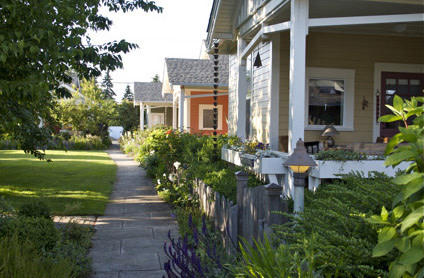Small Spaces That Delight

The Puget Sound town of Langley, WA is where architect Ross Chapin built his first "pocket neighborhood" of cottage homes oriented around a central green.
Image: Courtesy of Ross Chapin
It’s a headscratcher, a conundrum, a paradox: how can we in Portland manage to be all green and sustainable, but still have a strong economy and plenty of good jobs for everyone and support for local businesses? If we’re truly green, we wouldn’t be buying new things all the time, would we? And we wouldn’t be building big houses, or even new houses, perhaps. The most sustainable cities are often in low income, less developed, non-Western countries where people have no choice but to walk everywhere, live close together with family and neighbors, and make do with whatever old clothes, furniture and household items they have until the stuff is beyond repair. But that's not a solution to the question of how to be "sustainable."
That said, the recent Build Small, Live Large conference, held at Portland State University and sponsored by, among others, Metro and the Cascadia Green Building Council, was an intriguing and informative gathering of nearly 300 local (and not so local) proponents of what was billed as a “market revival for single-family housing.” Developers, realtors, builders, academics, architects, planners and students considered aspects of Big Living in Small Spaces, single family style.
The Cascadia Green Building Council is part of the International Living Future Institute, and also acts as a chapter of both the US and Canadian Green Building Councils. (Cascadia is the only chapter that crosses national borders.) The audience that its conference drew was mostly comprised of those who are already part of the choir of green and sustainable living advocates, but it’s significant how much that choir has grown and diversified in recent years. This ain’t your grandfather’s yogurt and granola gang of hippies.
Green design is almost a given these days, and in that context consumers are realizing that size and place are factors in how green a design is. A house may be built to Platinum LEED standards, but if it’s 3000 square feet, and two people live there, and it’s located out in some sprawly distant suburb, and the people drive 30 miles to work everyday... well, you get the picture. LEED for buildings (organized by the Green Building Council) expanded into LEED for "neighborhood development" (LEED-ND) not long ago. The move was necessary, but so are more moves.
Jordan Palmeri, one of the organizers of the conference and the Green Building Specialist at the Oregon Department of Environmental Quality, is well aware of the picture, and helping to paint it in detail for all of us. He's documented how a smaller house built to existing building code requirements outperforms the energy efficiency of a larger home built to very high green building and energy standards.
Architect Ross Chapin of Washington gave the keynote speech, tracking the origins of his evolving concept of building "Pocket Neighborhoods" (he's written a book by the same title) of small, cottage-sized homes oriented around a communal green. It's an old concept, but when he proposed it in the mid-'90s for a parcel of land in the Puget Sound area, it seemed new. Eight houses could fit onto the site instead of the four large houses (too large, by his estimate) that would have fit in a "traditional" suburban plan. The project, Third Street Cottages, was a success, and he's been rolling the bandwagon for cottages in pocket neighborhoods ever since.
The concept isn't about going without or giving things up as much as it is about gaining a sense of community and an easy simplicity in one's life. And the concept of building small homes in welcome proximity to one another is not Chapin's or anyone else's idea alone. It is a movement, though, in the best sense of the word – and one that needs as many movers as possible. The Accessory Dwelling Unit movement in Portland is part of the same trend, as is the national (and local) trend of co-housing. Their stories are just beginning to be lived, and told.
